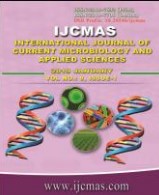


 National Academy of Agricultural Sciences (NAAS)
National Academy of Agricultural Sciences (NAAS)

|
PRINT ISSN : 2319-7692
Online ISSN : 2319-7706 Issues : 12 per year Publisher : Excellent Publishers Email : editorijcmas@gmail.com / submit@ijcmas.com Editor-in-chief: Dr.M.Prakash Index Copernicus ICV 2018: 95.39 NAAS RATING 2020: 5.38 |
The field experiment was conducted at Horticulture Farm, S.K.N. College of Agriculture, Jobner (Jaipur) during Rabi season 2016-17 and 2017-18. The experiment consisted of thirty five treatment combinations including seven INM (100 per cent RDF through inorganic fertilizer, 75 per cent RDF through inorganic fertilizer + 25 per cent through FYM (5 t/ha), 50 per cent RDF through inorganic fertilizer + 50 per cent through FYM, 100 per cent RDF through FYM, 75 per cent RDF through inorganic fertilizer + 25 per cent through VC, 50 per cent RDF through inorganic fertilizer + 50 per cent through VC and 100 per cent RDF through vermicompost and five bio-regulators levels [Control, Brassinoids @ 5 ppm, Brassinoids @ 10 ppm, Salicylic acid @ 100 ppm and Salicylic acid @ 150 ppm] were under taken in Split plot design with three replications. The results showed that the maximum TSS (10.58 0Brix), nitrogen content (0.365%), protein content (2.28 %), phosphorus content (0.083 %) potash content (0.278 %) were recorded with the application of 50 per cent RDF through inorganic fertilizer and 50 per cent through vermicompost in sprouting broccoli. Ascorbic acid content was found non significant. Similarly, different bio-regulators significantly increased the TSS (10.18 0Brix), nitrogen content (0.335%), protein content (2.11 %), phosphorus content (0.077 %) potash content (0.261 %), were recorded significant with foliar application of 5 ppm brassinoids while ascorbic acid content was found non significant to broccoli.
 |
 |
 |
 |
 |